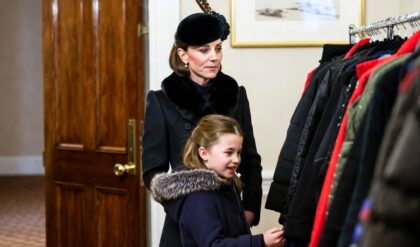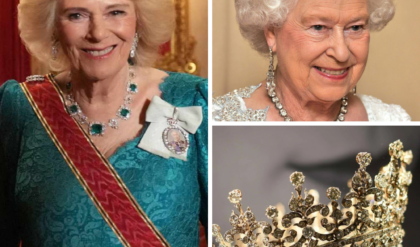Do you know how sexy Brad Pitt is? He’s so sexy that People named him Sexiest Man Alive twice. Only he, George Clooney, Richard Gere, and Johnny Depp have been bestowed the honor more than once, and Pitt’s were just a few years apart, first in 1995 and then again in 2000. Such was the power of Pitt at his apex: so hot that a magazine had to scream it twice, nationally, on the glossy cover, in just a little more time than it takes to pick an American president.
It was a combination of 1994’s Legends of the Fall and Interview with the Vampire, and his new relationship with future Goop tastemaker Gwyneth Paltrow, that made Pitt—with his shoulder-length blond hair and precise stubble—so attractive. In his 1995 People cover story, he’s described as “good-looking, intelligent, and sensitive,” the trifecta for a man appealing to a modern woman of the ’90s. He wasn’t just a hot guy—he was the perfect guy. To dream of the perfect man is to dream of the impossible, and an actor like Pitt suggests he could be just that: good-looking, intelligent, and sensitive, indeed.
For most of his career, Brad Pitt has been the name you come up with when someone asks you to imagine the male movie star. Not an action guy like Tom Cruise, not a moody art-flick weirdo like Joaquin Phoenix. Pitt’s movies were critical and commercial successes, from Seven to the Ocean’s trilogy to Fight Club, a film from which a generation of young men took the wrong message (and we’ve all been paying for it ever since). His reputation was pristine, both personally and professionally. He was charming, likable, and bankable; in later years, his roles as husband to Angelina Jolie and father to their six children seemed to only bolster his profile.
It was only when Pitt and Jolie filed for divorce in 2016, and in the eight-plus-year legal proceedings that followed, that cracks in his image began to show as alleged details of their marriage filtered down to the public. A court filing by Jolie, submitted as a cross-complaint against Pitt in 2022, made public the ugly details of their split. The filing says that during a private flight from France to California in September 2016, days before Jolie filed for divorce, Pitt accused her of being “too deferential” to their kids. According to her account, he yelled at her in the bathroom, grabbed her by the head and shook her, pushed her into the wall, punched the plane’s ceiling, and poured alcohol on Jolie and the kids. When their children tried to defend their mother, the filing continues, Pitt “choked” one and “struck” another in the face.
Pitt has disputed that account of events, and the FBI, along with the Los Angeles County Department of Children and Family Services, closed the investigation of the incident without filing charges. Jolie has said very little publicly about the specifics of what happened on that plane, but has brought a lawsuit against the FBI. Her complaint includes the claim that the agent investigating the 2016 incident laid out a statement of probable cause for charging Pitt. Meanwhile, the press has reported that most of Pitt’s children—who have been the subject of a prolonged custody battle between their parents—no longer speak to him. A few have dropped his last name in public. (A representative for Pitt declined to comment for this story.)
Despite all that has come out about Pitt’s alleged behavior toward his second wife and kids—and what came even before that, if you care to look more closely—his reputation has remained largely intact. The allegations made against him have been brushed over or studiously ignored by Hollywood tastemakers, the press, and vast swaths of the public. He continues to get the glossy-magazine-cover treatment at GQ. He’s still the babyface hawking coffee beans and Chanel’s fall/winter ready-to-wear line. He’s remained dutifully employed, with his latest movie, Wolfs—a collaboration between Pitt, old friend George Clooney, and Apple, which is reportedly paying them $35 million each to star in the film—out in theaters on Sept. 20.
That’s the thing about Brad Pitt: He’s Brad Pitt. Unlike many of his contemporaries who have struggled to regain a foothold in Hollywood after getting into trouble, Pitt has managed to thoroughly launder his reputation with limited blowback. In this retelling, he is a man wounded by the women to whom he gave his heart; a humanitarian and a feminist ally who has used his production work to bring to life women-focused films; a recovering addict on a journey of self-healing and growth. To challenge Pitt’s narrative is to confront our own complicity as an audience, one that’s always been eager to hear—and believe—his version of the story.
Brad Pitt, born in Oklahoma and raised in Missouri, moved to Los Angeles in the late ’80s to kickstart his acting career in CBS procedurals and forgettable comedies. In 1991, he got the first of a few big breaks—including as a Levi’s model in an ad where he is freed from a Mexican jail possessing nothing but a film camera, only to be picked up by a hot brunette who gives him a new pair of jeans that fit him like a glove. That year, Pitt was also featured as J.D., Geena Davis’ love interest in Thelma & Louise, an armed robber on the run who eventually steals all of her money and bails on her. “J.D. appears as the perfect antidote to all the toxic masculinities that Thelma and Louise encounter on their journey,” Manuela Lazic wrote in the Ringer in 2020. “J.D. listens and talks only when his opinion is requested,” the piece goes on. “J.D. enjoys all the preliminaries and doesn’t need to force himself on her to get her into bed.”
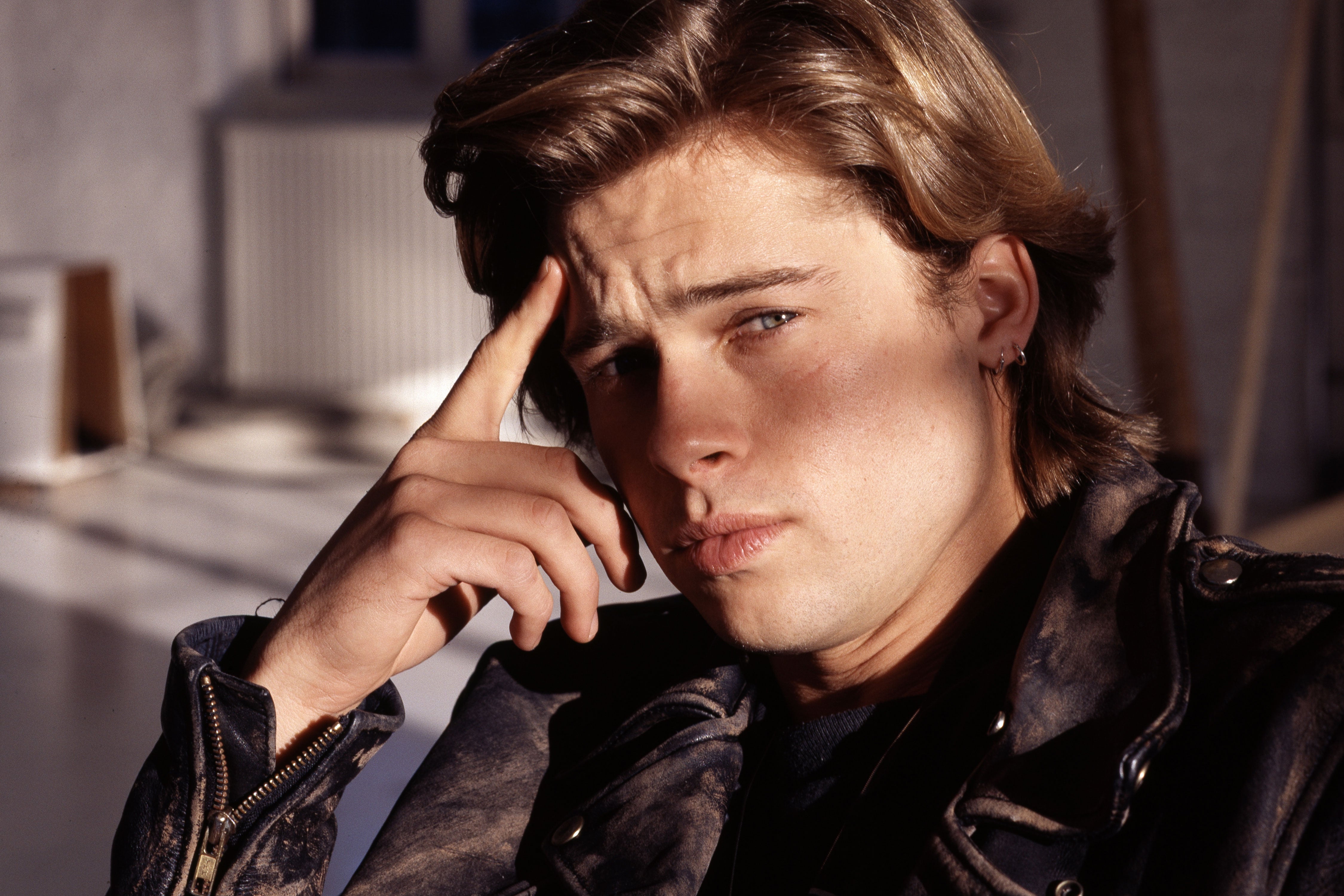
Brad Pitt in London in 1988. Photo by Michael Putland/Getty Images
Thelma & Louise—and even the Levi’s ad—marked the beginning of what would be Brad Pitt’s zenith: his ability to playact as the man of your dreams, even when he was kind of the bad guy. Charming, with just a soupçon of rot and abs like a pack of King’s Hawaiian rolls, he was a guy you could safely fantasize about. His personal life suggested he was worthy of adoration, too: In 1994, he started dating rising star and Hollywood royalty Gwyneth Paltrow, speaking adoringly about her in the press. “Why do people get married? For the bad times,” he told Rolling Stone after they got engaged in 1996. “Marriage is an amazing thing,” he added. “I’m only going to do it once.”
Pitt, in fact, did not only do it once. He and Paltrow never married, and were broken up a year later, ushering in Pitt’s next relationship with another likable daughter of Hollywood cosplaying as girl-next-door. When he was set up on a date with Jennifer Aniston by their agents in 1998, it was kismet. America’s Sweetheart and America’s Sharpest Male Jaw, together at last. They were a bona fide supercouple, the ideal relationship of any star-worshipper’s dream. It’s hard to explain how big the Pitt/Aniston wedding was to someone steeped in today’s celebrity bridal culture. These days, 200 guests in Malibu with 50,000 flowers and a Melissa Etheridge performance seems almost quaint; 24 years ago, a $1 million wedding was considered ludicrous and yet utterly watchable, so much so that airspace above the wedding was restricted to keep paparazzi in helicopters away.
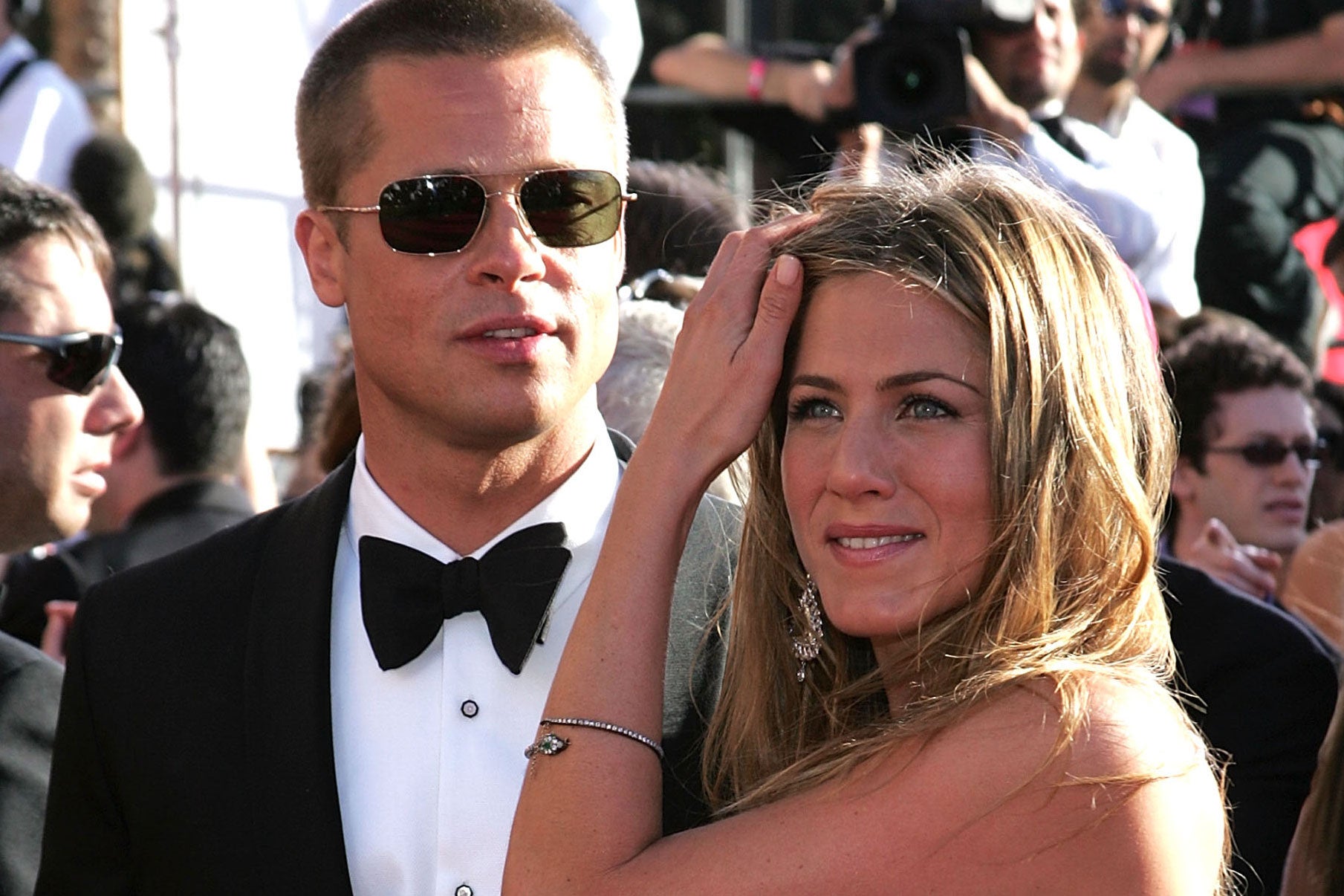
Brad Pitt and Jennifer Aniston attend the 56th Annual Primetime Emmy Awards in 2004. Photo by Carlo Allegri/Getty Images
Five years after they tied the knot, they announced their split in People magazine. The divorce became legend, and front-page news, like when the homecoming king and queen break up the summer after graduation. Despite the niceties of their coordinated PR statement, lurking under the surface were rumors about the “real” reason for their divorce: Pitt wanted kids, while Aniston didn’t. She was a ruthless careerist preventing her husband from fulfilling his destiny of having children—it was fourth-wave feminism that broke them up! “You could tell the emotion and see it in [Pitt’s] heart, this is what he wanted more than anything,” People magazine executive editor Peter Castro told ABC News. “But she wasn’t there with him.”
From there, tabloids spent the next decade and a half painting Aniston as either a cold workaholic who ran her marriage into the ground or a pitiful, aging crone who was desperate for a baby. OK!, Star, In Touch, and Us Weekly wrote headline after headline about Aniston’s nonexistent pregnancies; variations of “I’ll Raise This Baby Alone!” or “Pregnant & Alone” were splashed on covers lining every grocery checkout counter for most of the mid-2000s. In reality, Aniston was struggling with IVF. The “narrative was that I was selfish. I just cared about my career,” she told Allure in 2022. “It was absolute lies.” A friend close to Aniston told Vanity Fair at the time that, actually, it was Pitt who didn’t want children. “Did he think, I need to get out of this marriage, but I want to come out smelling like a rose,” the friend said, “so I’m going to let Jen be cast as the ultra-feminist and I’m going to get cast as the poor husband who couldn’t get a baby and so had to move on?”
Two months after Pitt and Aniston announced their split, the Mr. & Mrs. Smith star was seen vacationing with his co-star Jolie and her then 3-year-old son, Maddox, in Kenya. After they officially stepped out together as a couple in 2006, there was breathless tabloid coverage about Pitt adopting Jolie’s children, and then of their eventually having three more together, all sharing the Jolie-Pitt surname. While Aniston was getting alternately attacked and patronized in the press, Pitt let the public mutate the fight into one not between him and his ex-wife, but instead between his ex-wife and his new girlfriend. While blogs, tabloids, and regular folks were deciding if they were Team Jolie or Team Aniston, Pitt seemed to be a virtual nonentity in this love triangle that triangulated largely around him.
Granted, it was never entirely a fair fight. Why would anyone take Aniston’s side when Jolie was right there? Jolie was a steward of the world, having become a very public activist at that point, flying around as a goodwill ambassador for the United Nations, adopting children around the world. Jolie—all tits and hips and lips—gave Pitt those kids he had been yearning for. On her worst day, Jolie was seen as a homewrecking slut; on Aniston’s worst day, she was a barren hag.
But Jolie scored the greatest point in her inadvertent battle against Aniston: She got the guy. Brad Pitt, golden boy and dutiful second husband, remained the ultimate prize.
If Pitt’s star power amplified Jolie’s celebrity and reaffirmed her likability, then her reformed image as a tattooed, brother-kissing weirdo-turned-mommy helped Pitt eradicate his own culpability from the record. It was never his fault that his first marriage ended, or that he had (allegedly) been enticed by another woman while simply doing his job. The rumors of the onset of their relationship didn’t make a better story than the inevitable conclusion of them ending up together, a coupling so powerful that we called them by one name: Brangelina.
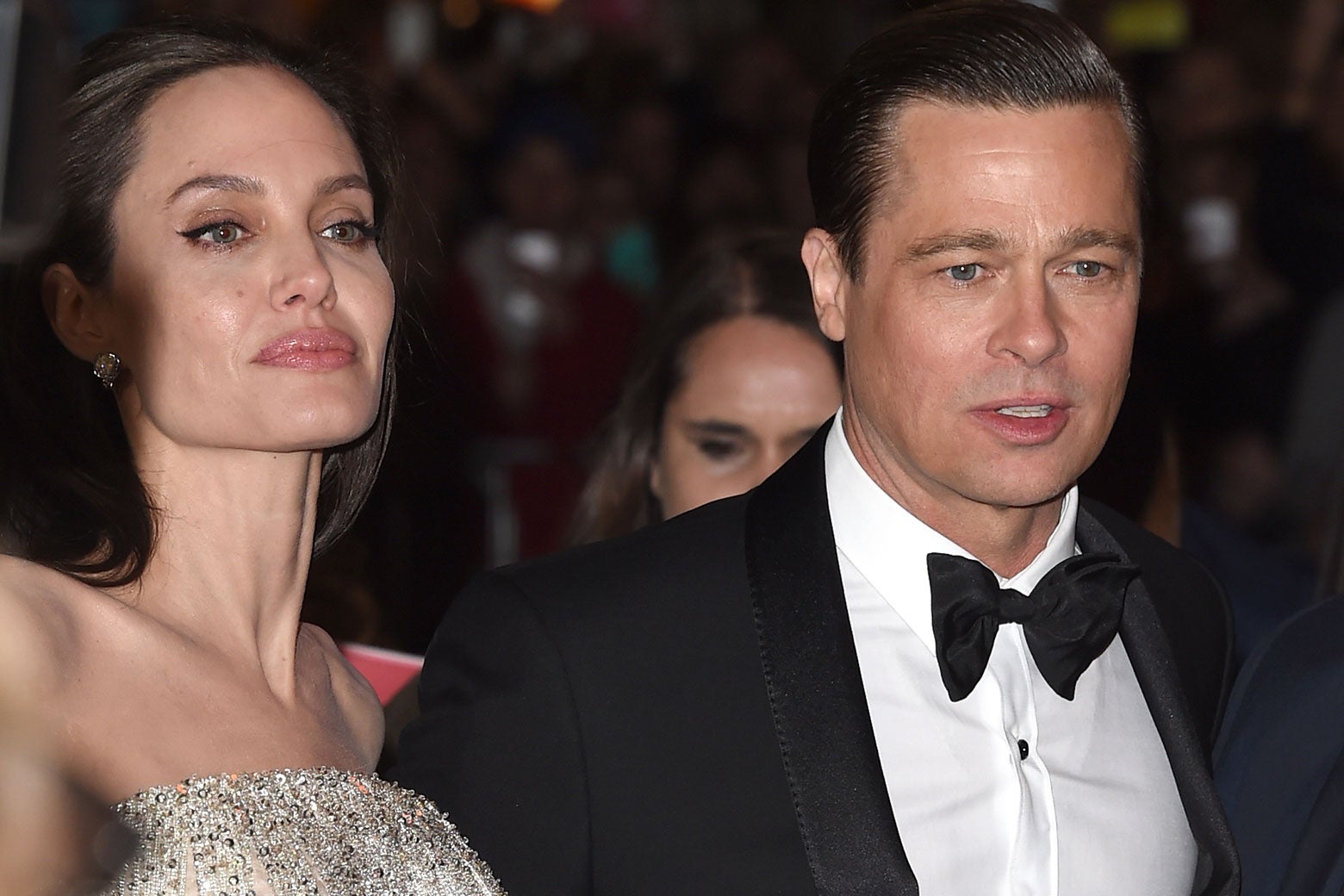
Angelina Jolie and Brad Pitt attend AFI Fest 2015. Photo by Jason Merritt/Getty Images
Pitt’s irreproachability was further burnished by Jolie’s humanitarian shine, which rubbed off on him. He leaned into a new version of himself, one that was more charitable and more foundationally patriarchal, right down to the infamous W Magazine photoshoot in which Pitt, opposite Jolie, cosplayed some version of Father Knows Best. After Hurricane Katrina in 2005, Pitt started the Make It Right Foundation to help rebuild houses in New Orleans’ Lower Ninth Ward. People ran photos of Jolie and Maddox at press conferences for Make It Right’s many projects. (Make It Right would eventually promise to give these homeowners millions of dollars because the homes themselves were unlivable.) Through Jolie, Pitt was inhabiting a new role that would further protect him from scrutiny over his personal choices: fatherhood. And while he and Jolie were building their lives together, the tabloids were in lockstep, always describing Pitt as a devoted husband and deeply involved parent. Even now, at 60, the tabloids are still writing headlines about how he wants more kids.
After only two years of marriage, the star couple announced their 2016 separation to People, with Jolie filing for divorce soon thereafter. Media coverage of the end of Brangelina was breathless, but less sure where to place the blame. People reported that Pitt was “wrecked” over Jolie’s decision to leave, and that he “begged” her to stay with him. USA Today reported that Jolie, diverging from her husband, was more focused on her work with the U.N. and less interested in acting. It was only TMZ that initially reported that Jolie was tired of Pitt’s alleged weed and alcohol abuse, and that she was worried about his “anger problem.” The tabloid also noted how “significant” it was that Jolie was asking that Pitt not have joint physical custody of their kids, and instead that he be granted visitation. But, by and large, Pitt was being portrayed as an abandoned husband who wanted to save the marriage. It didn’t help that Jolie had hired Laura Wasser, perhaps the country’s most famous divorce attorney. Jolie went from being the other woman, to the wife, to the bitter ex trying to ruin a good man’s name.
Pitt, though—he was a good guy, right? In 2017, in the same story in which Jolie told the New York Times that she—among countless other women in and out of the movie business—had been sexually harassed by movie producer Harvey Weinstein in the late 1990s, Paltrow shared an account of how, in 1995, her then-boyfriend Pitt had confronted Weinstein after the film producer had harassed her. “I think the interesting thing is that we, Hollywood specifically, but the workplace, men and women’s dynamics is being recalibrated, recalibrated in a very good way that is long overdue. And I do think that’s an important story to tell,” Pitt told CNN in 2019, sharing his side of the story. He has been applauded for standing up to Weinstein, but even after that alleged confrontation, Pitt went on to work with the producer twice more: first in 2009 with Inglourious Basterds, which Weinstein produced and distributed, and then in 2012 with Killing Them Softly, which was distributed by the Weinstein Company. (The Daily Beast reported that a source close to Pitt said Weinstein’s involvement, and their interactions, were “limited.”) What did Jolie, his partner at the time, think of Pitt’s involvement with Weinstein? “I never associated or worked with him again,” she said in 2021. “It was hard for me when Brad did. We fought about it. Of course it hurt.”
That same year, Jolie sold her stake in Château Miraval, the French vineyard she and Pitt co-owned, and the place where they had wed in 2014. Pitt sued her for it in 2022, saying she was intentionally trying to “inflict harm” on him by selling her half “in secret.” Steadily, a more fulsome story of their divorce began unfurling. Acting as a Jane Doe, Jolie filed a Freedom of Information Act suit requesting that FBI documentation about the 2016 plane incident be released. The redacted documents included allegations that, while on a private jet, Pitt grabbed Jolie, shook her, pushed her into a wall, punched the ceiling, and poured a beer on her before pouring wine on his kids, hitting one in the face and choking another.
In response to the details of this incident going public, Jolie was treated similarly to Amber Heard, who has repeatedly accused her ex-husband, Johnny Depp, of physically and verbally abusing her. (Depp won a defamation case against Heard in the United States over her allegations, but lost a similar case against the Sun newspaper in the U.K.) An NBC News investigation found that online content creators were suggesting Jolie was using “Amber Heard” tactics, that their divorce would be “the next Depp v. Heard.” The questions weren’t around what happened on the plane or how Pitt might respond; it was all about whether Jolie was lying in order to tear down a powerful man she was once married to. Even the response to her maintaining custody and contact with her kids has led a vocal faction of people online to suggest that Jolie is poisoning their children against Pitt.
Such accusations show no signs of slowing down as the pair’s divorce proceedings continue. In August, People reported that Pitt was trying to get his ex-wife to sign an $8.5 million nondisclosure agreement. Jolie’s lawyers said it was “specifically designed to force her silence about his abuse and cover-up.”
As Jolie has continued to withdraw from Hollywood amid their legal battle—she’s said that she’s only sticking around Los Angeles because of their custody agreement over their teenage twins—Pitt kept working. He starred in films like 2022’s Bullet Train, which came out right after details of the jet incident did, and made $240 million worldwide.
But far more interesting than Pitt’s movie parts has been his producing work, which has played a significant role in how he has reframed his reputation. In 2001, he started Plan B productions with Aniston and his then-manager; when they divorced, he became the sole owner of the company. In 2006, Pitt started producing movies himself, first with films that fit well within his own wheelhouse, like The Departed, but as he became more ensconced in his evolving brand as Adoring Wife Guy, these projects changed, too. In 2009, while appearing in Inglourious Basterds, he also executive produced The Time Traveler’s Wife and The Private Lives of Pippa Lee. In 2010, he produced Eat, Pray, Love. He also started producing more movies featuring and written by people of color, like critical darlings If Beale Street Could Talk, 12 Years a Slave, and Minari.
But it has been hard not to notice that since the FBI report detailing the plane incident was made public, Pitt’s production company has taken a special interest in movies about women. In 2022, he produced Women Talking, a woman-led and woman-directed movie inspired by a series of rapes that happened within a Mennonite community. He also produced She Said, an adaptation of the Jodi Kantor and Megan Twohey book about the journalistic investigation into Weinstein.
The strangeness of someone like Pitt being involved in She Said—after being accused of abusing his wife, and having worked with Weinstein even after he learned about Weinstein’s harassment of Paltrow and Jolie—wasn’t lost on anyone when the movie was released. His involvement in the project now smells like light reputational laundering. She Said wasn’t a huge box-office hit, but it was nominated for awards by the Women Film Critics Circle and the Alliance of Women Film Journalists. (It won Best Ensemble at the AARP Movies for Grownups Awards.) Women Talking was nominated for Best Picture at the Oscars, and writer-director Sarah Polley won for Best Adapted Screenplay. (Conversely, Women Talking was merely nominated for Best Ensemble at the AARP Movies for Grownups Awards.)
As Pitt became an even more dominant power player in Hollywood, he simultaneously embarked on a personal transformation. In the time between his divorce from Jolie and her allegations that he abused her, Pitt publicly acknowledged his alcohol addiction issues, sitting down for a lengthy 2017 interview with GQ about his yearlong sobriety. He appeared on three different covers, all shot in national parks, all with Pitt looking a little like a chastened Tyler Durden: graying goatee, torso covered with a tornado tattoo, same bright blue eyes tearing up in one particular photo. His alleged assault of his ex-wife is, in the GQ story, referred to as “a reported altercation.” Pitt is framed as a pitiable figure: “Here he is, alone, a 53-year-old human father/former husband smack in the middle of an unraveled life, figuring out how to mend it back together.”
Getting sober—and talking about it—is a path that has been taken by countless famous men caught in a fire of their own making. For instance, Rob Lowe, whose career took a brief nosedive after he made a sex tape, at the age of 24, with a 22-year-old woman and a 16-year-old girl, recently celebrated 34 years of sobriety. A sobriety journey can be both a legitimate path for someone’s individual well-being and a clever way to rebrand oneself after being found guilty in, at minimum, the court of public opinion. It can be a triumph, while also serving as a distraction.
Pitt’s sobriety journey went hand in hand with a renewed interest in speaking about his parenting ethos. In the 2017 GQ interview, Pitt dances around the specifics of his sobriety while framing most of his concerns around his children and how they’ll manage with divorced parents. “I’m personally very retarded when it comes to taking inventory of my emotions,” he said. “And it’s hit me smack in the face with our divorce: I gotta be more. I gotta be more for them. I have to show them. And I haven’t been great at it.”
What the glossy magazines are still hesitant to bring up is that Pitt appears to be largely estranged from his children. In 2020, Jolie and Pitt’s son Pax allegedly wrote an Instagram story on Father’s Day calling Pitt a “world class asshole,” a “despicable person,” and a “fucking awful human being.” Several of the kids have dropped their dad’s last name. In November 2023, their daughter Zahara was announced by her sorority as “Zahara Marley Jolie.” Last May, it was reported that Vivienne had started using just Jolie as a last name. Shiloh dropped Pitt from her last name in August, right after turning 18. In August, Pax ended up in the ICU after an e-bike accident. “He hasn’t had any contact with Pax in years,” an anonymous source told People, “but he still very much cares.”
He may only be 60, but Pitt still represents a last vestige of Hollywood glamour. Pitt existed in the time of monoculture, where one movie—like Fight Club or Seven or Legends of the Fall—could dominate every conversation for weeks. Coupled with his universally good looks, his penchant for dating it girls of every ilk (the elegant Paltrow, the winning Aniston, the sexy Jolie), and his eventual fatherhood, he made for a celebrity you could cheer on. Even his sobriety plot offers us, his dutiful audience, a nice bow to tie together his redemption narrative. It feels good to root for someone who we think already deserves our affection.
The crux of the matter is mortifyingly simple: It’s painful for an audience to let go of a beloved cultural icon. Could someone this hot, this talented, and this charming be responsible for real harm? Sean Penn, Josh Brolin, Jerry Seinfeld, and Johnny Depp have been accused of some form of abuse of power against women or girls, and yet all of them remain pretty bankable stars, not canceled so much as transformed into folk heroes to a very particular audienc.
Pitt’s upcoming film Wolfs is classic Pitt/Clooney fare: Two fixers who normally operate alone are forced to work together on one complicated job. The publicity machine has been hot: In August, In Touch wrote about how supportive Clooney has been through his friend’s divorce. A few days after that, the outlet published another story about how much the two pals “check in on each other” despite growing apart during Pitt’s second marriage. People wrote about it, too. GQ put Pitt and Clooney on the cover again, with a PR-friendly interview about their three-decade-long friendship; Us Weekly aggregated the details. There was no mention of Pitt’s ongoing divorce, or the alleged estrangement between him and his children.
Pitt may be able to launder his reputation a thousand times through ex-wives disinterested in public squabbles, or summer blockbusters that everyone wants to see, or production work in support of female voices. But, as he gets older, and as the routine becomes more familiar, it’s an image of him that’s harder to buy. Nothing speaks louder than your own children united in their displeasure, disapproval, and disappointment.
Meanwhile, Pitt and his second ex-wife passed like ships in the night at this year’s Venice Film Festival, where they both had movies premiere earlier this month. Pitt went public with his thirtysomething girlfriend; Jolie gave interviews about despair.
